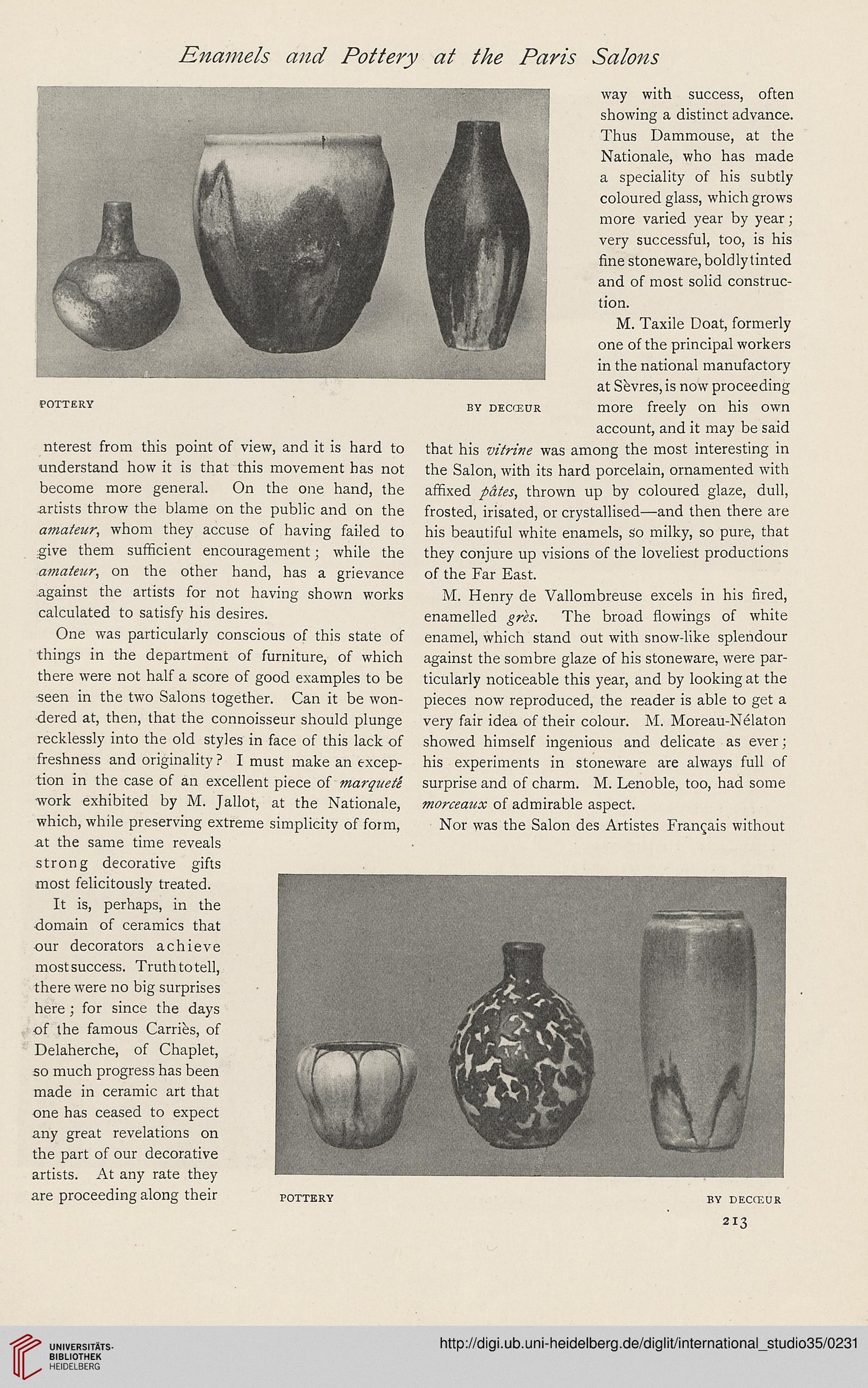Enamels and Pottery at the Paris Salons
nterest from this point of view, and it is hard to
understand how it is that this movement has not
become more general. On the one hand, the
artists throw the blame on the public and on the
amateur, whom they accuse of having failed to
give them sufficient encouragement; while the
amateur, on the other hand, has a grievance
.against the artists for not having shown works
calculated to satisfy his desires.
One was particularly conscious of this state of
things in the department of furniture, of which
there were not half a score of good examples to be
•seen in the two Salons together. Can it be won-
dered at, then, that the connoisseur should plunge
recklessly into the old styles in face of this lack of
freshness and originality ? I must make an excep-
tion in the case of an excellent piece of marquete
work exhibited by M. Jallot, at the Nationale,
which, while preserving extreme simplicity of form,
.at the same time reveals
strong decorative gifts
most felicitously treated.
It is, perhaps, in the
•domain of ceramics that
our decorators achieve
most success. Truth to tell,
there were no big surprises
here ; for since the days
of the famous Carries, of
Delaherche, of Chaplet,
so much progress has been
made in ceramic art that
one has ceased to expect
any great revelations on
the part of our decorative
artists. At any rate they
are proceeding along their
way with success, often
showing a distinct advance.
Thus Dammouse, at the
Nationale, who has made
a speciality of his subtly
coloured glass, which grows
more varied year by year;
very successful, too, is his
fine stoneware, boldly tinted
and of most solid construc-
tion.
M. Taxile Doat, formerly
one of the principal workers
in the national manufactory
at Sevres, is now proceeding
more freely on his own
account, and it may be said
that his vitrine was among the most interesting in
the Salon, with its hard porcelain, ornamented with
affixed pates, thrown up by coloured glaze, dull,
frosted, irisated, or crystallised—and then there are
his beautiful white enamels, so milky, so pure, that
they conjure up visions of the loveliest productions
of the Far East.
M. Henry de Vallombreuse excels in his fired,
enamelled gres. The broad flowings of white
enamel, which stand out with snow-like splendour
against the sombre glaze of his stoneware, were par-
ticularly noticeable this year, and by looking at the
pieces now reproduced, the reader is able to get a
very fair idea of their colour. M. Moreau-Nelaton
showed himself ingenious and delicate as ever;
his experiments in stoneware are always full of
surprise and of charm. M. Lenoble, too, had some
morceaux of admirable aspect.
Nor was the Salon des Artistes Fran^ais without
nterest from this point of view, and it is hard to
understand how it is that this movement has not
become more general. On the one hand, the
artists throw the blame on the public and on the
amateur, whom they accuse of having failed to
give them sufficient encouragement; while the
amateur, on the other hand, has a grievance
.against the artists for not having shown works
calculated to satisfy his desires.
One was particularly conscious of this state of
things in the department of furniture, of which
there were not half a score of good examples to be
•seen in the two Salons together. Can it be won-
dered at, then, that the connoisseur should plunge
recklessly into the old styles in face of this lack of
freshness and originality ? I must make an excep-
tion in the case of an excellent piece of marquete
work exhibited by M. Jallot, at the Nationale,
which, while preserving extreme simplicity of form,
.at the same time reveals
strong decorative gifts
most felicitously treated.
It is, perhaps, in the
•domain of ceramics that
our decorators achieve
most success. Truth to tell,
there were no big surprises
here ; for since the days
of the famous Carries, of
Delaherche, of Chaplet,
so much progress has been
made in ceramic art that
one has ceased to expect
any great revelations on
the part of our decorative
artists. At any rate they
are proceeding along their
way with success, often
showing a distinct advance.
Thus Dammouse, at the
Nationale, who has made
a speciality of his subtly
coloured glass, which grows
more varied year by year;
very successful, too, is his
fine stoneware, boldly tinted
and of most solid construc-
tion.
M. Taxile Doat, formerly
one of the principal workers
in the national manufactory
at Sevres, is now proceeding
more freely on his own
account, and it may be said
that his vitrine was among the most interesting in
the Salon, with its hard porcelain, ornamented with
affixed pates, thrown up by coloured glaze, dull,
frosted, irisated, or crystallised—and then there are
his beautiful white enamels, so milky, so pure, that
they conjure up visions of the loveliest productions
of the Far East.
M. Henry de Vallombreuse excels in his fired,
enamelled gres. The broad flowings of white
enamel, which stand out with snow-like splendour
against the sombre glaze of his stoneware, were par-
ticularly noticeable this year, and by looking at the
pieces now reproduced, the reader is able to get a
very fair idea of their colour. M. Moreau-Nelaton
showed himself ingenious and delicate as ever;
his experiments in stoneware are always full of
surprise and of charm. M. Lenoble, too, had some
morceaux of admirable aspect.
Nor was the Salon des Artistes Fran^ais without




